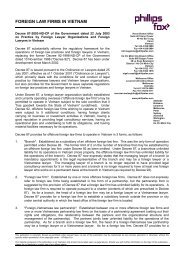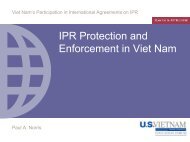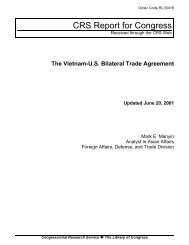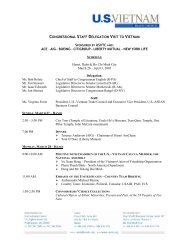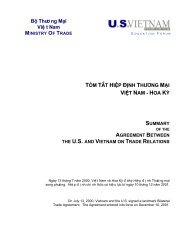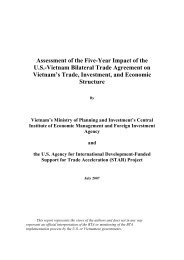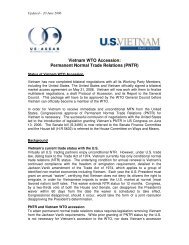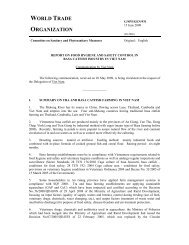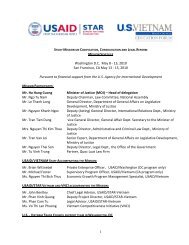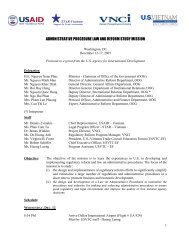Climate risks and adaptation in Asian coastal megacities: A synthesis
Climate risks and adaptation in Asian coastal megacities: A synthesis
Climate risks and adaptation in Asian coastal megacities: A synthesis
- No tags were found...
You also want an ePaper? Increase the reach of your titles
YUMPU automatically turns print PDFs into web optimized ePapers that Google loves.
Box 2.1 ■ Strengths <strong>and</strong> Limitations of Different Downscal<strong>in</strong>g TechniquesSelected for this StudyThe city studies utilized two different downscal<strong>in</strong>g techniques—pattern scal<strong>in</strong>g which is a k<strong>in</strong>d of statistical downscal<strong>in</strong>g, <strong>and</strong> dynamic downscal<strong>in</strong>gtechniques. The first was undertaken for all the studies. The HCMC study also used dynamic downscal<strong>in</strong>g. Briefly, statistical downscal<strong>in</strong>g techniques are“based on the construction of relationships between large scale <strong>and</strong> local variables calibrated from historical data” (Jones et al. 2004). These statisticalrelationships are then applied to large-scale climate variables from AOGCM simulations to estimate correspond<strong>in</strong>g local/regional characteristics (liketemperature <strong>and</strong> precipitation). Pattern scal<strong>in</strong>g, one of the techniques used <strong>in</strong> this work, is a form of statistical downscal<strong>in</strong>g that requires m<strong>in</strong>imalregional meteorological data <strong>and</strong> is computationally not very complicated. In pattern scal<strong>in</strong>g the change <strong>in</strong> the local variable of <strong>in</strong>terest—liketemperature or precipitation—is represented <strong>in</strong> terms of the GCM’s change for the variable per unit change <strong>in</strong> global temperature (this is the scal<strong>in</strong>gfactor). This factor is then multiplied by the global change <strong>in</strong> temperature associated with a specific IPCC scenario (A1FI <strong>and</strong> B1). In this specific case,the scal<strong>in</strong>g factor was obta<strong>in</strong>ed by perform<strong>in</strong>g a l<strong>in</strong>ear regression on a number of GCM models available (see Sugiyama 2008 for details). The ma<strong>in</strong>advantage of statistical downscal<strong>in</strong>g is that it is computationally not very expensive <strong>and</strong> can provide <strong>in</strong>formation at po<strong>in</strong>t locations. However, amongseveral limitations, one issue is that the statistical relationships may not rema<strong>in</strong> the same <strong>in</strong> a future climate world <strong>and</strong> the method does not provide<strong>in</strong>formation on temporal <strong>and</strong> location l<strong>in</strong>kages.In contrast, dynamical model<strong>in</strong>g techniques use physical models of the climate system allow<strong>in</strong>g direct model<strong>in</strong>g of the dynamics of the physicalsystems that <strong>in</strong>fluence the climate of a region. They are rapidly becom<strong>in</strong>g the most widely applied downscal<strong>in</strong>g technique. New systems like PRECIS—usedby the HCMC study—can be utilized from a PC platform, but they can still generate a broad range of daily, site-specific (i.e., 25 kms resolution grids)hydrometeorological data for time periods spann<strong>in</strong>g a century. This allows exam<strong>in</strong>ation of time slices like 2030 to 2070 to establish frequency relationsfor events <strong>in</strong> 2050 that can <strong>in</strong>clude both floods <strong>and</strong> droughts. Boundary conditions need to be derived from coupled GCMs. Nevertheless, RCMs also havea number of potential pitfalls that need to be understood. They require large amounts of boundary data l<strong>in</strong>ked with the parent GCM, acquire the errors ofthe parent GCM, <strong>and</strong> (as is the case with PRECIS) may take several months to run. An additional limitation is their potential exclusive reliance on only oneAOGCM. Before apply<strong>in</strong>g the RCM, the user needs to underst<strong>and</strong> whether it can model the types of events (e.g., typhoons) that are of particular <strong>in</strong>terest<strong>in</strong> the study. Typically, for studies that <strong>in</strong>volve downscal<strong>in</strong>g analysis such as disaster risk assessments, when try<strong>in</strong>g to <strong>in</strong>corporate climate change riskfactors <strong>in</strong>to the analysis, statistical downscal<strong>in</strong>g or regional climate models are likely to be the methods of choice.Source: Authors’ compilation.pact parameters (e.g., precipitation <strong>and</strong> temperature<strong>in</strong>crease) that are generated are applied <strong>in</strong> estimat<strong>in</strong>gflood impacts at the city level. Try<strong>in</strong>g to quantifythese uncerta<strong>in</strong>ties—<strong>and</strong> given a confidence <strong>in</strong>tervalfor the outcomes—is extremely difficult, <strong>and</strong> someuncerta<strong>in</strong>ties—like future emission scenarios—cannotbe assessed. However, despite these uncerta<strong>in</strong>ties,the IPCC AR4 recognizes that the AOGCMclimate change models do allow global forecasts,<strong>and</strong> that <strong>in</strong>creas<strong>in</strong>gly the downscal<strong>in</strong>g techniquesare provid<strong>in</strong>g <strong>in</strong>formation on the likely scale of differentclimate impacts at local levels (Giorgi 2008).Estimates for changes <strong>in</strong> temperature <strong>and</strong>precipitation <strong>in</strong> 2050 based on statisticaldownscal<strong>in</strong>g approachThe statistical downscal<strong>in</strong>g technique used <strong>in</strong> thestudy (see Sugiyama 2008) 16 provided estimates of(a) the expected temperature <strong>in</strong>creases, (b) extreme24-hour precipitation <strong>in</strong>crease factors, <strong>and</strong> (c) seasonalmean precipitation <strong>in</strong>creases for 2050 for thetwo climate change scenarios A1FI <strong>and</strong> B1. Thesefactors were derived from16 AOGCMs models forall four cities <strong>and</strong> are shown <strong>in</strong> Table 2.1.The robustness of the relationships was exam<strong>in</strong>edstatistically by the IR3S team by exam<strong>in</strong><strong>in</strong>gthe scatter among the data po<strong>in</strong>ts generated by thedownscal<strong>in</strong>g of the 16 AOGCMs. They found robustrelations for global <strong>and</strong> local temperature <strong>and</strong>precipitable water (used as a proxy for extreme precipitation)relationships, <strong>and</strong> viable but less strongrelationships for the temperature/mean seasonalprecipitation <strong>in</strong>creases. How this was h<strong>and</strong>led isexpla<strong>in</strong>ed <strong>in</strong> Box 2.2.16This part of the analysis was carried out by IntegratedResearch System for Susta<strong>in</strong>ability Science (IR3S) at theUniversity of Tokyo. The results are presented <strong>in</strong> Sugiyama(2008).Methodologies for Downscal<strong>in</strong>g, Hydrological Mapp<strong>in</strong>g, <strong>and</strong> Assess<strong>in</strong>g Damage Costs | 7



